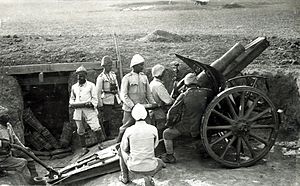| Battle of Hareira and Sheria | |||||||
|---|---|---|---|---|---|---|---|
| Part of the Middle Eastern theatre of World War I | |||||||
 Ottoman 10.5-centimetre (4.1 in) howitzer at Hareira | |||||||
| |||||||
| Belligerents | |||||||
|
| |||||||
| Commanders and leaders | |||||||
|
|
| ||||||
| Units involved | |||||||
| |||||||
The Battle of Hareira and Sheria was fought on 6–7 November 1917 when the Egyptian Expeditionary Force attacked and captured the Yildirim Army Group's defensive systems protecting Hareira and Sheria in the centre of the Gaza to Beersheba line, during the Southern Palestine Offensive of the Sinai and Palestine Campaign in World War I.
These defensive systems, which had successfully repelled frontal attacks during the Second Battle of Gaza, became vulnerable, after a six months' stalemate, to a flanking manoeuvre by the XX Corps on 6 November. This was made possible by the capture of Beersheba on 31 October after which Ottoman defenders had been pushed back north from the town into the Judean Hills, during the Battle of Tel el Khuweilfe. The 74th (Yeomanry) Division attacked the eastern end of the defences from the eastern flank, while the 60th (2/2nd London) Division attacked the Kauwukah and Rushdi defensive systems from the south-eastern flank.
The eastern end of the Ottoman defences was captured in a preliminary attack by the Yeomanry, which was followed by the main attack by the Londoners, supported by the 10th (Irish) Division on the left. The right flank of this attacking force was covered by the Yeomanry Mounted Division, while their left flank was covered by the Australian Mounted Division. The attacks by the three infantry divisions, supported by effective artillery barrages, resulted in the capture of the Kauwukah and Rushdi defences, after fierce fighting. Towards dusk the Londoners reformed in preparation for an attack on Sheria Station, and across the Wadi esh Sheria to the fortifications on Tel esh Sheria. The attack was progressing after sundown, when the Ottoman garrison destroyed a large ammunition dump near the station, lighting up the night sky. The Londoners attack across the wadi, having lost the benefit of darkness, was halted for the night. Although the Londoners captured a wadi and Tel esh Sheria, fierce fighting during a series of Ottoman counter-attacks on 7 November prevented the Londoners advancing.
The Australian Mounted Division was ordered to clear the way for the infantry, when the 4th Light Horse Brigade moved through the Londoners to charge the strongest Ottoman position. Although the light horsemen were ordered to dismount in the face of fierce fire, one troop which succeeded in gaining the redoubt were decimated in the process of dismounting to get their rifles off their backs. After being held through the day, late in the afternoon another attack by the 60th (London) and the Australian Mounted Divisions captured the Ottoman rearguard. This attack, along with the occupation of Gaza during the morning, broke the Ottoman line. Seven days later, as a consequence of the EEF victory at the Battle of Mughar Ridge, Jaffa was occupied and on 9 December 1917 after the Battle of Jerusalem, that city was occupied and a new EEF line established from Jaffa to Jerusalem.
